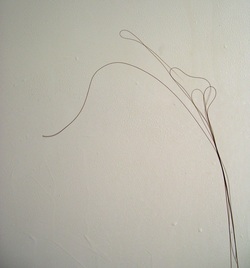I have been reading a little bit about the genre of still life lately--how throughout history it has tended to focus on mundane and overlooked objects while negating the human form. In the early 1600s, it was pretty avant-garde for a painting's sole subject matter to be a few fruits and vegetables rather than the portrait of a king or the depiction of a historical scene.
Today, ironically, I think still life itself has become overlooked or maybe just associated too much with academic art. It brings to mind impersonal and sometimes tedious beginning drawing assignments of stacks of boxes and other unrelated odds and ends. There's something amazing, though, about the concentrated seeing involved in drawing one of these still lifes or in viewing a still life. One of my favorite paintings is Juan Sánchez Cotán's Still Life with Quince, Cabbage, Melon, and Cucumber from about 1600 pictured below:
Today, ironically, I think still life itself has become overlooked or maybe just associated too much with academic art. It brings to mind impersonal and sometimes tedious beginning drawing assignments of stacks of boxes and other unrelated odds and ends. There's something amazing, though, about the concentrated seeing involved in drawing one of these still lifes or in viewing a still life. One of my favorite paintings is Juan Sánchez Cotán's Still Life with Quince, Cabbage, Melon, and Cucumber from about 1600 pictured below:
What I really love about this painting is its geometrical composition and the simplicity of the forms suspended in front of a dark void. Because of this, I concentrate only on the objects as my eye travels back and forth on the graceful curve created by the alignment of the forms in space. Something as simple as a few fruits and vegetables can incite a sense of discovery and interest when looked at closely in a particular arrangement.
The art historian Norman Bryson brings up some intriguing points about this sense of discovery and concentrated seeing when viewing Cotán's still lifes: "Sight is taken back to a vernal stage before it learned how to scotomise the visual field, how to screen out the unimportant and not see, but scan. In place of the abbreviated forms for which the world scans, Cotán supplies forms that are articulated at immense length...Just at the point where the eye thinks it knows the form and can afford to skip, the image proves that in fact the eye had not understood at all what it was about to discard" (Page 65 of Bryson's Looking at the Overlooked).
As much as I look at this painting, my eye continues to return to the round quince depicted in the upper left of the canvas and follow the curve down and up again, down and up, as if there is an infinite number of times in seeing it anew, yet it is always the same painting.
The art historian Norman Bryson brings up some intriguing points about this sense of discovery and concentrated seeing when viewing Cotán's still lifes: "Sight is taken back to a vernal stage before it learned how to scotomise the visual field, how to screen out the unimportant and not see, but scan. In place of the abbreviated forms for which the world scans, Cotán supplies forms that are articulated at immense length...Just at the point where the eye thinks it knows the form and can afford to skip, the image proves that in fact the eye had not understood at all what it was about to discard" (Page 65 of Bryson's Looking at the Overlooked).
As much as I look at this painting, my eye continues to return to the round quince depicted in the upper left of the canvas and follow the curve down and up again, down and up, as if there is an infinite number of times in seeing it anew, yet it is always the same painting.


 RSS Feed
RSS Feed
